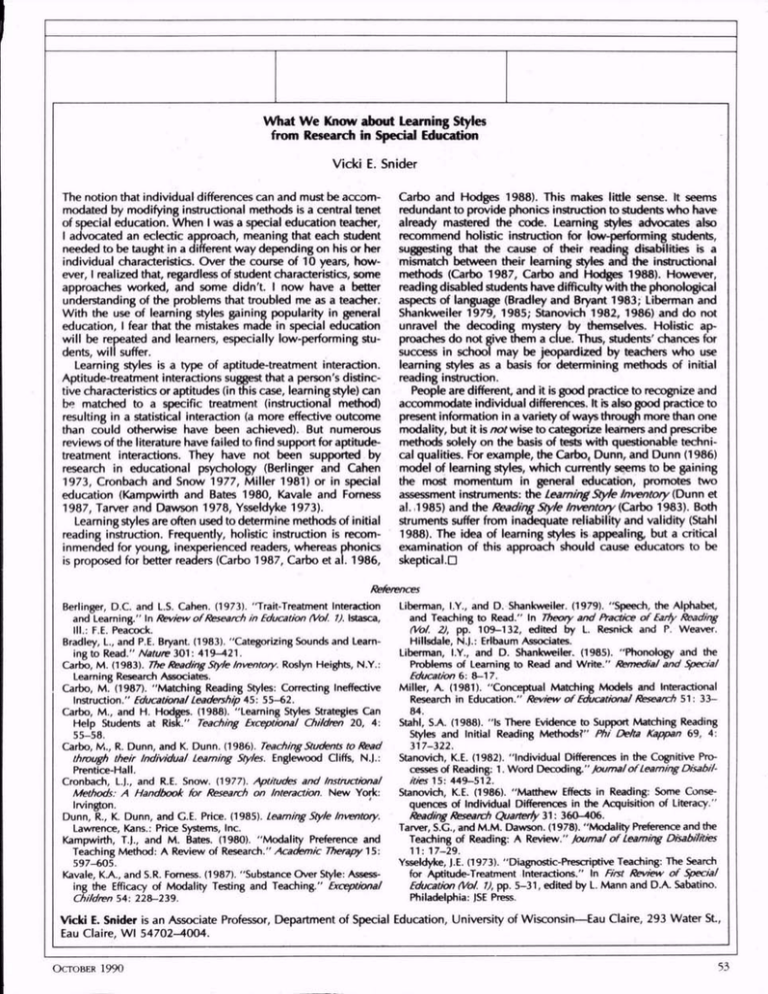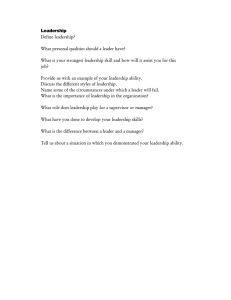
What We Know about Learning Styles
from Research in Special Education
Vicki E. Snider
The notion that individual differences can and must be accom
modated by modifying instructional methods is a central tenet
of special education. When I was a special education teacher,
I advocated an eclectic approach, meaning that each student
needed to be taught in a different way depending on his or her
individual characteristics. Over the course of TO years, how
ever, I realized that, regardless of student characteristics, some
approaches worked, and some didn't. I now have a better
understanding of the problems that troubled me as a teacher.
With the use of learning styles gaining popularity in general
education, I fear that the mistakes made in special education
will be repeated and learners, especially low-performing stu
dents, will suffer.
Learning styles is a type of aptitude-treatment interaction.
Aptitude-treatment interactions suggest that a person's distinc
tive characteristics or aptitudes (in this case, learning style) can
be matched to a specific treatment (instructional method)
resulting in a statistical interaction (a more effective outcome
than could otherwise have been achieved). But numerous
reviews of the literature have failed to find support for aptitudetreatment interactions. They have not been supported by
research in educational psychology (Berlinger and Cahen
1973, Cronbach and Snow 1977, Miller 1981) or in special
education (Kampwirth and Bates 1980, Kavale and Forness
1987, Tarver and Dawson 1978, Ysseldyke 1973).
Learning styles are often used to determine methods of initial
reading instruction. Frequently, holistic instruction is recominmended for young, inexperienced readers, whereas phonics
is proposed for better readers (Carbo 1987, Carbo et ai. 1986,
Carbo and Hodges 1988). This makes little sense. It seems
redundant to provide phonics instruction to students who have
already mastered the code. Learning styles advocates also
recommend holistic instruction for low-performing students,
suggesting that the cause of their reading disabilities is a
mismatch between their learning styles and the instructional
methods (Carbo 1987, Carbo and Hodges 1988). However,
reading disabled students have difficulty with the phonological
aspects of language (Bradley and Bryant 1983; Liberman and
Shanlcweiler 1979, 1985; Stanovich 1982, 1986) and do not
unravel the decoding mystery by themselves. Holistic ap
proaches do not give them a clue. Thus, students' chances for
success in school may be jeopardized by teachers who use
learning styles as a basis for determining methods of initial
reading instruction.
People are different, and it is good practice to recognize and
accommodate individual differences. It is also good practice to
present information in a variety of ways through more than one
modality, but it is not wise to categorize learners and prescribe
methods solely on the basis of tests with questionable techni
cal qualities. For example, the Carbo, Dunn, and Dunn (1986)
model of learning styles, which currently seems to be gaining
the most momentum in general education, promotes two
assessment instruments: the Learning Style Inventory (Dunn et
al. 1985) and the Heading Style Inventory (Carbo 1983). Both
struments suffer from inadequate reliability and validity (Stahl
1988). The idea of learning styles is appealing, but a critical
examination of this approach should cause educators to be
skeptical.D
References
Berlinger, D.C. and L.S. Cahen. (1973). "Trait-Treatment Interaction
and Learning." In Review of Research in Education tVo/. V. Istasca,
III.: F.E. Peacock.
Bradley, L., and P.E. Bryant. (1983). "Categorizing Sounds and Learn
ing to Read." Nature 3O1: 419-421.
Carbo, M. (1983). The Heading Style Inventory. Roslyn Heights, N.Y.:
Learning Research Associates.
Carbo, M. (1967). "Matching Reading Styles: Correcting Ineffective
Instruction." Educational Leadership 45: 5 5-62.
Carbo, M., and H. Hodges. (1988). "Learning Styles Strategies Can
Help Students at Risk." Teaching Exceptional Children 20, 4:
55-58.
Carbo, M., R. Dunn, and K. Dunn. (1986). Teaching Students to Read
through their Individual Learning Styles. E ngtewood Cliffs, N.J.:
Prentice-Hall.
Cronbach, L.)., and R.E. Snow. (1977). Aptitudes and Instructional
Methods: A Handbook tor Research on Interaction. New York:
Irvington.
Dunn, R., K. Dunn, and C.E. Price. (1985). Learning Style Inventory.
Lawrence, Kans.: Price Systems, Inc.
Kampwiith, T.J., and M. Bates. (1980). "Modality Preference and
Teaching Method: A Review of Research." Academic Therapy 1 5:
597-605.
Kavale, K.A., and S.R. Fomess. (1987). "Substance Over Style: Assess
ing the Efficacy of Modality Testing and Teaching." Exceptional
Children 54: 2 28-239.
Liberman, I.Y., and D. Shankweiler. (1979). "Speech, the Alphabet,
and Teaching to Read." In Theory and Practice of Earty Reading
(vol. 2), pp. 109-132, edited by L. Resnick and P. Weaver.
Hilbdate, N.J.: Eribaum Associates.
Liberman, I.Y., and D. Shankweiler. (1985). "Phonology and the
Problems of Learning to Read and Write." Remedial and Special
Education 6 : 8-17.
Miller, A. (1981). "Conceptual Matching Models and Interactional
Research in Education." Review of Educational Research 5 1: 3384.
Stahl, S.A. (1988). "Is There Evidence ID Support Matching Reading
Styles and Initial Reading Methods?" Phi Deita Kappan 69, 4:
317-322.
Stanovich, K.E. (1982). "Individual Differences in the Cognitive Pro
cesses of Reading: 1. Word Decoding." loumal of Learning Disabil
ities^: 449-512.
Stanovich, K.E. (1986). "Matthew Effects in Reading: Some Conse
quences of Individual Differences in the Acquisition of Literacy."
Reading Research Quarterly 3 1: 360-406.
Tarver, S.C., and M.M. Dawson. (1978). "Modality Preference and the
Teaching of Reading: A Review." loumal of Learning Disabilities
11: 17-29.
YsseWyke, I.E. (1973). "Diagnostic-Prescriptive Teaching: The Search
for Aptitude-Treatment Interactions." In First Review of Special
Education (Vol. V, pp. 5-31, edited by L. Mann and D.A. Sabatino.
Philadelphia: ISE Press.
Vicki E. Snider is an Associate Professor, Department of Special Education, University of Wisconsin—Eau Claire, 293 Water St,
Eau Claire, Wl 54702-4004.
OCTOBER 1990
53
Copyright © 1990 by the Association for Supervision and Curriculum
Development. All rights reserved.




